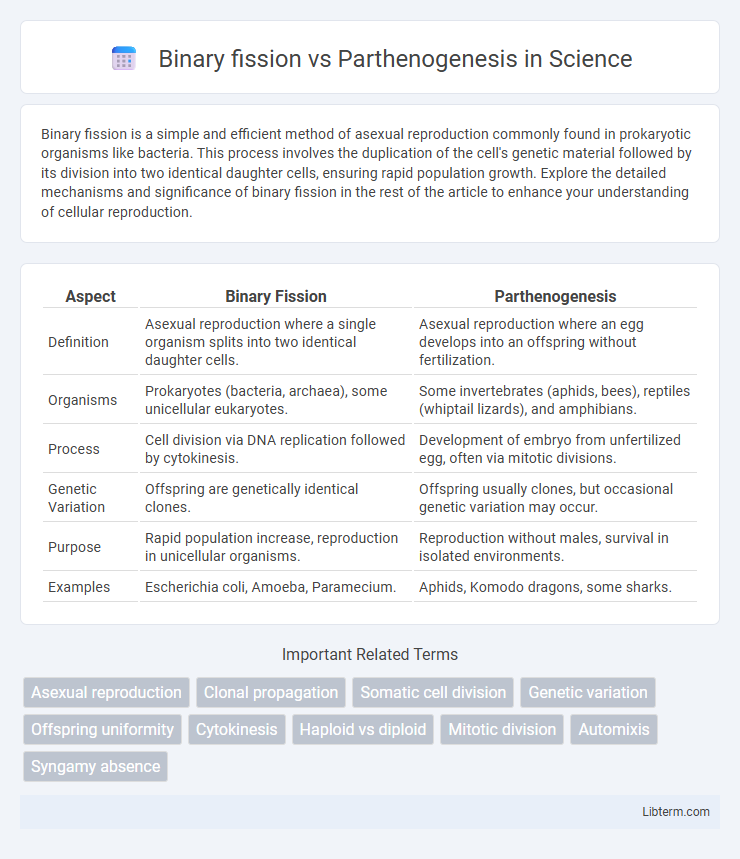Binary fission is a simple and efficient method of asexual reproduction commonly found in prokaryotic organisms like bacteria. This process involves the duplication of the cell's genetic material followed by its division into two identical daughter cells, ensuring rapid population growth. Explore the detailed mechanisms and significance of binary fission in the rest of the article to enhance your understanding of cellular reproduction.
Table of Comparison
| Aspect | Binary Fission | Parthenogenesis |
|---|---|---|
| Definition | Asexual reproduction where a single organism splits into two identical daughter cells. | Asexual reproduction where an egg develops into an offspring without fertilization. |
| Organisms | Prokaryotes (bacteria, archaea), some unicellular eukaryotes. | Some invertebrates (aphids, bees), reptiles (whiptail lizards), and amphibians. |
| Process | Cell division via DNA replication followed by cytokinesis. | Development of embryo from unfertilized egg, often via mitotic divisions. |
| Genetic Variation | Offspring are genetically identical clones. | Offspring usually clones, but occasional genetic variation may occur. |
| Purpose | Rapid population increase, reproduction in unicellular organisms. | Reproduction without males, survival in isolated environments. |
| Examples | Escherichia coli, Amoeba, Paramecium. | Aphids, Komodo dragons, some sharks. |
Introduction to Asexual Reproduction
Asexual reproduction involves a single organism producing offspring without genetic contribution from another individual, enabling rapid population growth and genetic uniformity. Binary fission, common in prokaryotes like bacteria, entails the organism dividing into two identical daughter cells through DNA replication and cytoplasmic division. Parthenogenesis occurs in some animals and plants where an unfertilized egg develops into a new individual, bypassing the need for fertilization and maintaining genetic homogeneity.
Defining Binary Fission
Binary fission is a type of asexual reproduction primarily observed in prokaryotic organisms, such as bacteria, where a single cell divides into two genetically identical daughter cells. The process involves DNA replication, chromosome segregation, and division of the cytoplasm, ensuring rapid population growth without genetic recombination. In contrast, parthenogenesis is an asexual reproduction mode in some multicellular organisms, such as certain insects and reptiles, where offspring develop from unfertilized eggs.
Understanding Parthenogenesis
Parthenogenesis is a type of asexual reproduction where offspring develop from unfertilized eggs, common in certain invertebrates, reptiles, and plants. Unlike binary fission, which involves the division of a single organism into two identical parts, parthenogenesis results in progeny that are often genetically similar but can exhibit variation due to mechanisms like automixis. Understanding parthenogenesis is crucial for studying reproductive strategies, genetic diversity, and evolutionary adaptations in species capable of this unique form of reproduction.
Key Biological Differences
Binary fission is an asexual reproduction process primarily observed in prokaryotes like bacteria, where a single organism divides into two genetically identical daughter cells. Parthenogenesis occurs mainly in certain plants, invertebrates, and vertebrates, involving the development of an egg into an offspring without fertilization, resulting in genetic clones or variation depending on the species. Unlike binary fission, which involves cell division, parthenogenesis is a form of embryogenesis without the fusion of gametes, highlighting fundamental differences in reproductive mechanisms.
Organisms Exhibiting Binary Fission
Binary fission is a common asexual reproduction method predominantly exhibited by prokaryotic organisms such as bacteria and archaea, where a single cell divides into two genetically identical daughter cells. This process involves DNA replication, chromosome segregation, and cytokinesis, facilitating rapid population growth in species like Escherichia coli and Amoeba. In contrast to parthenogenesis, which occurs in some multicellular eukaryotes, binary fission is primarily characteristic of unicellular organisms enabling efficient genetic material duplication and distribution.
Species Practicing Parthenogenesis
Species practicing parthenogenesis include certain reptiles like whiptail lizards, invertebrates such as aphids and water fleas, and some fish species, enabling them to reproduce without fertilization. This asexual reproduction method contrasts with binary fission, predominantly seen in prokaryotes like bacteria, where a single cell divides into two identical daughter cells. Parthenogenetic species often utilize this mechanism to rapidly increase populations in stable environments while maintaining genetic stability.
Genetic Variation: A Comparative Analysis
Binary fission produces genetically identical offspring through asexual reproduction, resulting in minimal genetic variation since the DNA is copied directly from the parent cell. Parthenogenesis, while also a form of asexual reproduction, can introduce some genetic variation due to mechanisms such as automixis or the involvement of meiosis, which allows for recombination and genetic diversity in offspring. Consequently, parthenogenetic species often exhibit greater genetic variation compared to organisms reproducing solely via binary fission, influencing their adaptability and evolution.
Evolutionary Advantages and Disadvantages
Binary fission offers rapid population growth through simple and efficient cell division, providing an evolutionary advantage in stable environments but limiting genetic diversity and adaptability. Parthenogenesis enables reproduction without fertilization, which is beneficial in isolated or low-population conditions, yet it also reduces genetic variation, increasing vulnerability to environmental changes and diseases. Both methods favor survival in specific ecological niches but may hinder long-term evolutionary potential due to constrained genetic recombination.
Ecological and Environmental Contexts
Binary fission predominantly occurs in prokaryotic organisms such as bacteria, facilitating rapid population growth in nutrient-rich environments and playing a crucial role in ecosystem nutrient cycling and decomposition. Parthenogenesis, observed in certain invertebrates, reptiles, and fish, allows species to reproduce without males, providing a reproductive advantage in isolated or low-density populations where mates are scarce, thus ensuring species survival in fluctuating or challenging ecological conditions. Both reproductive strategies influence population dynamics and genetic diversity, impacting ecosystem stability and adaptability in varying environmental contexts.
Conclusion: Implications for Biodiversity
Binary fission enables rapid population growth by producing genetically identical offspring, leading to reduced genetic diversity yet efficient colonization. Parthenogenesis allows for reproduction without fertilization, maintaining species continuity but limiting genetic variation compared to sexual reproduction. Both mechanisms impact biodiversity by promoting species survival under stable conditions while potentially reducing adaptability to environmental changes.
Binary fission Infographic

 libterm.com
libterm.com